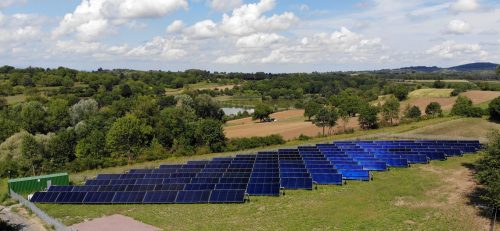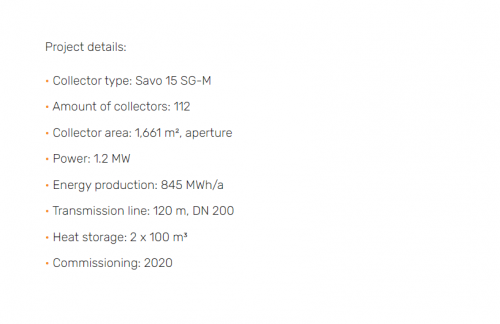Savosolar has supplied numerous solar thermal plants for district heating production in Denmark and France, among other countries. The plant in Ettenheim, delivered in the summer of 2020 to the Rhine Valley city of Ettenheim next to the Black Forest in southern Germany, is a business opening for Savosolar in the country, where solar heat is expected to grow strongly.
Savosolar’s customer is the local district heating company, Ettenheim Fernwärme GmbH, founded in 1999 by ratio energie GmbH in partnership with the City of Ettenheim and the School Foundation of the Archdiocese of Freiburg, which has many schools in south-west Germany. An engineering firm and contractor for thermal energy, ratio energie GmbH has been operating in southern Germany for almost 30 years, with a total of nine heating plants.
The CHP engine came to an end of its service life
At the Ettenheim district heating plant heat is mainly produced by a wood chip boiler. The solar power plant reduces combustion and replaced a CHP unit (combined heat and power) that used a gas engine. The largest user of thermal energy is a school and boarding school campus for 1,750 students. In addition, about 120 households are connected to the district heating network.
“Our gas engine was 18 years old and had reached the end of its service life,” says Peter Blaser, CEO of Fernwärme Ettenheim and one of the two owners of ratio energie. “The simplest thing would have been just a new engine, but we also wanted to evaluate more environmentally sustainable alternatives.
“We use wood chips normally from October to May and in the summer, when the energy demand is low, we have used the CHP plant. The calculated carbon dioxide (CO2) emissions of wood chips are zero and the total emissions consist only of the plant’s operations: pumps and motors. The CHP engine burned natural gas, which produced significant CO2 emissions.”
The Danish example encouraged choosing solar heat
Peter Blaser is sad about climate change and takes it very seriously. He sees that a great change has taken place in southern Germany over the last 20 years. Assessing the heating centres functioning, calculations are based on the average degree-day figures of 20th century’s later half. The coldest winter of the 21st century 2010 represented the average value of the calculations, all other winters over the last 20 years have been warmer.
“I have worked in supporting sustainable development now for 35 years and I am convinced that climate change is going to be the biggest problem of mankind. Alongside it, the loss of biodiversity will rise,” Blaser continues.
“Together with my partner Michael Pilgermayer, we are two partners sharing a similar idea of what needs to be done. Solar energy quickly came to mind for both of us when we were thinking about upgrading the CHP engine. We have received convincing evidence, for example, of Denmark’s achievements in the use of solar heat.
“We also had the opportunity to participate in a congress, the organiser of which exchanges information with Denmark and we were visited by some representatives of the industry from there. Finally, the website of Danish large scale solar thermal plants, their experience and energy production data convinced us and we took the project forward.”
A pioneer in energy and purity
Peter Blaser says they worked in Switzerland 30 years ago and at that time no one in south-west Germany was talking about wood chips. Only very small property-specific facilities were in use and ratio energie was the first to bring woodchip district heating to the region.
The Ettenheim plant was also very advanced at the time, in terms of flue gas condensation for example. Condensation substantially reduced particulate emissions while improving efficiency. The plant met today’s emission standards 20 years ago. There was no similar plant anywhere else in Germany.
“We want to think in the long term,” says Blaser. “We made accurate calculations of investment, operating costs and emissions. The investment in solar heat was 5-6 times higher than in a new gas engine. However, the engine consumes gas, which costs and produces emissions. In the short term, a new engine would have been cheaper, but after 7-8 years, the costs will be even and the sun will start to save us. The new engine would also be at the start of the end of its service life at that point.
“The price of CO2 emissions will rise sharply in the future, as it should. It is more difficult to assess fuel price developments. In a solar power plant, we have virtually no running costs, only the cost of capital, which is quite predictable.
“Of course, the choices also depend on the thinking of our partners. The school of the Catholic Church wants to protect the future and the city is committed to environmentally friendly energy. We also do not just think about maximising profits, but also want to take responsibility for the future.”
Solar power plant as a turnkey solution
Peter Blaser already had experience with solar energy when he once worked at a university to test collectors and heat storage. His firm, ratio energie, composed a call for tenders, which carefully reviewed the design’s starting points, needs and quality requirements.
Initially, the competition involved five flat plate collector suppliers and one tube collector provider. In the end, there was only one flat plate collector provider – Savosolar – as well as the tube collector.
“We had detailed discussions with all the candidates to make sure we understood all the conditions in the same way,” says Blaser. “At this stage, suppliers had the opportunity to correct any misunderstandings and get answers to all questions. After the definition phase, we requested bids. We only had one price round and didn’t bargain any more.
“This is a good collector! I am convinced about the Savosolar collector and its strong construction. In addition, Savosolar has extensive experience in turnkey deliveries of similar plants in many countries, although this is their first plant in Germany. I also want to help a good system enter the German market. It is clear that the importance of solar heat as the energy source of the future in the world will grow, especially as a district heating solution.
“The Covid-19 pandemic delayed the completion of the plant, but now we have a good product and a good plant. I’m glad and I’m proud!”
Solar energy for the district heating of the future
Savosolar built a solar power plant as a turnkey solution for Fernwärme Ettenheim, which comprises more than 110 Savosolar large area collectors and heat storage. The plant will primarily replace the district heating company’s old natural gas-fired CHP unit and save the resulting CO2 emissions.
Savosolar has developed groundbreaking collector technology which delivers the best efficiency on the market with its patented nanocoated direct flow absorbers. The company is focused on being a total supplier of solar district heating plants and process heating plants.
The system now delivered to Germany is one step in the shift away from fossil fuel use. Solar heat will be an integral part of this change.
Project details:
- Collector type: Savo 15 SG-M
- Amount of collectors: 112
- Collector area: 1,661 m², aperture
- Power: 1.2 MW
- Energy production: 845 MWh/a
- Transmission line: 120 m, DN 200
- Heat storage: 2 x 100 m³
- Commissioning: 2020
Facts: Fernwärme Ettenheim
District heating company in the town of Ettenheim in Rhine Valley, next to the Black Forest. Shareholders: ratio energie GmbH, City of Ettenheim, School Foundation of the Archdiocese of Freiburg. Established in 1999.
Heated facilities:
A school and boarding school campus for 1,750 students and 120 households. The length of the district heating network is 3.5km.
Heat production:
1,500kW wood chip boiler + flue gas condensing 250kW.
2×1,300kW oil burner for peak loads.
Annual delivery to users about 5,000MWh + network losses.
CHP plant replaced by the solar thermal plant:
200kW heat + 110kW electricity, gas-powered piston engine.
Solar heating plant:
Savosolar large area collectors, total area 1,700m2.
– Nanocoated direct flow absorbers.
Heat storage 2x100m3.
The maximum power of solar collectors is 1,200kW.
Estimated annual energy production 850MWh.
Reduction of CO2 emissions 150-160 t/a.


